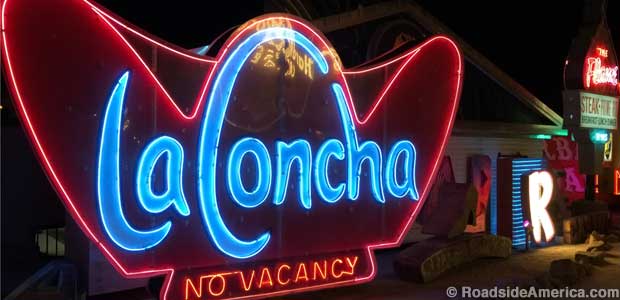
Working neon sign from the La Concha Motel.
Neon Museum - The Boneyard
Las Vegas, Nevada
Can the history of a town be told through its old neon signs? Sure -- as long as the town we're talking about is Las Vegas.
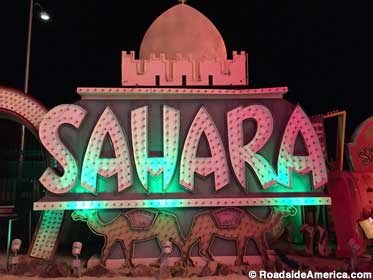
The Sahara.
Dead electric signs, once dismissed as the sad remains of businesses gone belly up, have found a new life as art. A caring preservationist can rescue and revive a vintage sign, a docent gives it context, and then adoring fans visit and snap pictures for Instagram love. That's what's happening at the Neon Sign Museum, where Boneyard guides leave visitors aglow in history and trivia about commerce, advertising, crime syndicates, atom bombs, and bad luck.
During its rise in the 1930s-60s, Las Vegas was ground zero for neon signs. Small neon signs first appeared at Vegas businesses in the late 1920s; the Boulder Club had a 12-ft. tall sign by 1929. A rival down the street soon erected a sign four feet taller. A sign size race ensued. The Young Electric Sign Company (YESCO) opened a branch in Las Vegas in 1932 and made a bigger neon sign for the Boulder Club. Other "clubs" (code word for gambling casino) quickly joined the neon rush, as downtown lit up with after-dark leisure.
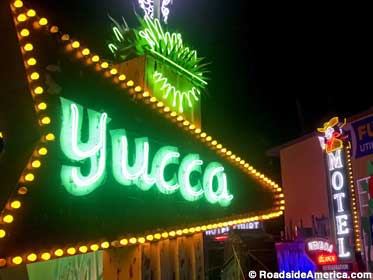
Yucca Motel.
In the 1990s we'd visited the YESCO Boneyard, a huge industrial storage lot where old signs were piled. It was an unofficial roadside attraction; the business still operated making and maintaining signs. Some were restored and installed during the big Fremont St. makeover (we saw a revived Aladdin's Magic Lamp, a giant high-heeled shoe, and a looming cowboy on horseback).
The Neon Museum formed in 1996, a wise partnership between the City and the Allied Arts Council of Southern Nevada. Though it initially lacked a large space to exhibit to the public, it set up restored signs downtown and along the Strip. Many more were parked at the 2.6-acre YESCO Boneyard, accessible only by appointment. That site was not a perfect refuge for the signs, piled in a dusty lot and exposed to the elements. In 2004, the grinning Mr. O'Lucky sign from Fitzgerald's Casino caught fire in the Boneyard, cause unknown. Museum officials at the time noted the sign's ample belly was a popular spot for homeless people.
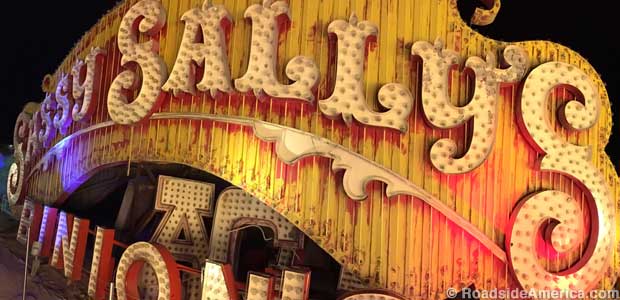
Sassy Sally's sign (1980-1999) was on Fremont St.
Then, in 2005, the retro-stylish 1961 lobby of the La Concha Motel, with its clam-shell roof, was donated to the museum -- just before the motel was demolished. The lobby was sectioned and moved north, next to the old YESCO boneyard site and reassembled in 2008. It became the lobby to the Neon Museum, and opened in 2012 with regular hours and tours.
We took the Boneyard night tour in 2019, (and had combo tickets for "Brilliant," a multimedia experience running in another part of the Boneyard). The Neon Boneyard's main collection features more than 200 unrestored signs, with flaking paint, rust spots and missing bulbs and wiring -- which are illuminated with lights at night. About 17 are electrified and restored. Visitors enjoy being close, hearing the hum of the tubes, the gentle ting of incandescent bulbs flicking on and off in sequence.
How Does a Neon Sign Work?
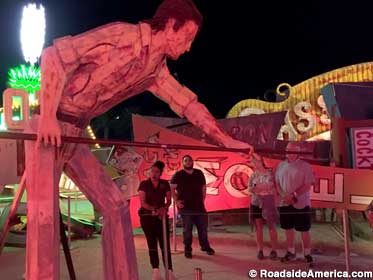
Giant metal pool player.
Without getting too geeky: Glass tubes on signs contain neon gas, an inert "noble gas" discovered in 1898, which an electrical current "excites" to glow with orange light. Other gases change the color (blue is from mercury gas), and fluorescent tube coatings expand the sign designer's color choices. Expert glass benders shape and curve the tubes, and electricians wire them for power and animation.
Neon Sign Business
Neon signs started appearing at Vegas businesses as early as 1928 (as the town blossomed after news the Hoover Dam would be built nearby), and continued to be popular into the 1960s. There were other manufacturers, but YESCO made about 27% of the signs in the museum collection (they also created the giant thermometer in Baker, CA).
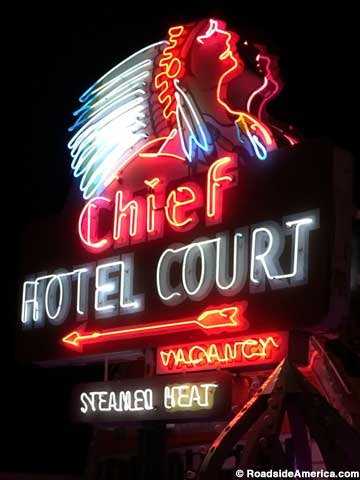
Chief Hotel Court neon sign ~1940.
Vegas's big sign businesses had a unique aspect: The casinos, clubs, and business didn't own their signs. They leased them from YESCO, who was responsible for installation and eventual dismantling when the contract ended, and maintenance in between. Our guide emphasized the importance of a working sign to economic health. Although it sounds slightly crazy, our guide said that if a few light bulbs or neon parts went out for even one night at a motel, lounge or casino's sign, it could be lights out for the business's bottom line, as prospective customers suspected the establishment was falling apart, and fled to a competitor.
The sign repair crews were on call, ready to respond to leased signs in distress, and to conduct repairs. The crews replaced bulbs every night.
Broken Bulbs of History
The Boneyard displays signs of epic scale -- one 2019 acquisition, the 82-ft tall neon Les Gibson electric guitar from the Hard Rock Cafe, towers above all. The collection also mixes in smaller signs -- a quirky animated pressed shirt from a dry cleaner waves its neon sleeves. There are signs from wedding chapels, cocktail lounges, and long gone motor courts. It's an essential tour for every fan of highway and Vegas commerce history, optimized for picture-taking. In a way, it's too easy -- our photos don't differ much from myriad other Boneyard snaps online.
Throughout the tours, the guides rattle off facts, and provide context of to the the eras that signs represent. For example, we're informed that Las Vegas had no authentic wild west history. It was a small railroad junction town. But you'd never guess that after seeing its glowing Chief Hotel sign, or its grinning, smoking Nevada Motel cowboy. The popularity of westerns in 1940s-60s television, film and toys translated into effective customer eye-catchers.
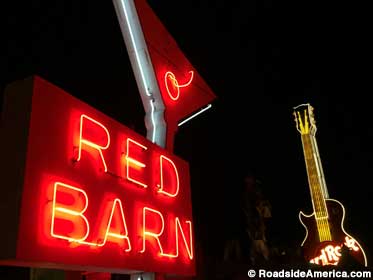
The Red Barn (1960s-1988) and Hard Rock Cafe guitar (1990).
Binion's Gambling Hall used to be the Horseshoe Casino, and our tour group learns that a giant horseshoe over a casino entrance affects a gambler's luck. This played out over decades for gamblers patronizing Binion's, who entered the casino by passing through its downturned horseshoe arches. Unfortunately, that imparts bad luck. The only upturned horseshoe was in the casino owner's office.
In the 1950s, Vegas had ringside seats to government nuclear tests in the desert 75 miles to the north. It was an era when the glamour and spectacle of an atomic detonation outweighed silly fears of radiation. A few signs from that period optimistically incorporated mushroom clouds.
In the 1990s, Vegas tried to appeal to families on vacation. Roadside America applauded the pivot, since it spawned many huge ridiculous landmarks, free shows, and other kid-friendly spectacles. But that shift is generally regarded as an economic disaster for Las Vegas, a misguided attempt to chase the Disney travel market. It was short-lived; businesses quickly realized families would only frequent free attractions and cheap buffets, but not spend money in casinos.
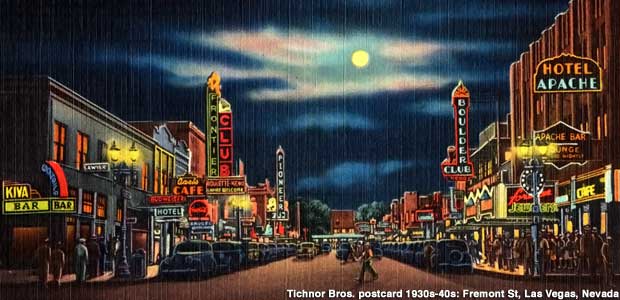
Downtown Las Vegas - neon wonder of the 1930s.
The Museum's biggest family marketing artifact is the giant Treasure Island casino pirate skull, left laying face up. There were actually two on The Strip, but one fell during the dismantling and broke into pieces.
The 1958 Stardust sign, rescued before the demolition in 2007, was 188 feet tall and 96 feet wide. And after the Liberace Museum closed in 2010, the Boneyard became home to its neon piano signs. Aside from all now secured in the Boneyard, and installations around town, the Neon Museum intends to save others. One of our favorites, the defunct motel Blue Angel figure, is owned by city -- it will be restored, and may end up at the museum.
We asked if neon, so popular with visitors, would ever have a resurgence. "The casinos are never going back to the neon," our guide said. It's way too much of an energy sink and maintenance nightmare compared to newer technology.





